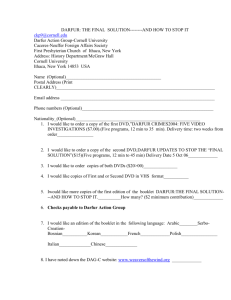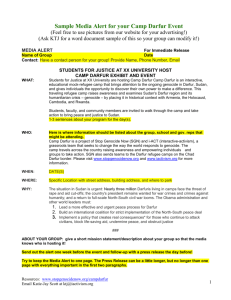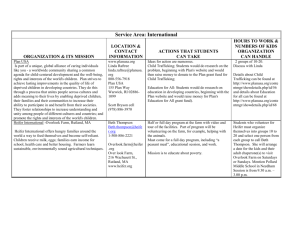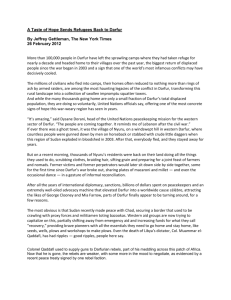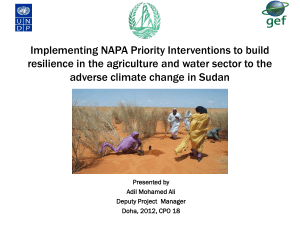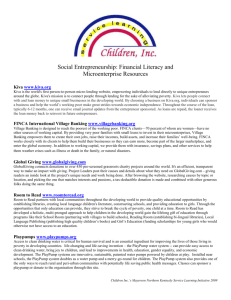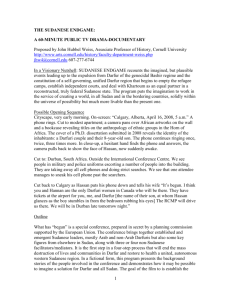Questions for the JDPC
advertisement
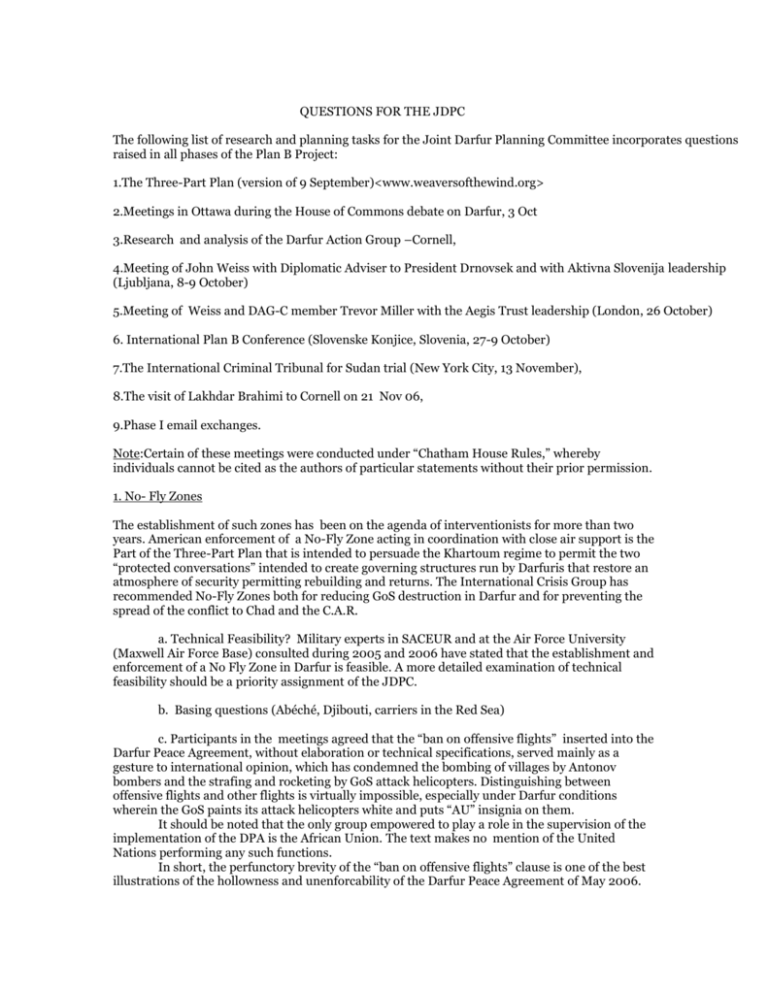
QUESTIONS FOR THE JDPC The following list of research and planning tasks for the Joint Darfur Planning Committee incorporates questions raised in all phases of the Plan B Project: 1.The Three-Part Plan (version of 9 September)<www.weaversofthewind.org> 2.Meetings in Ottawa during the House of Commons debate on Darfur, 3 Oct 3.Research and analysis of the Darfur Action Group –Cornell, 4.Meeting of John Weiss with Diplomatic Adviser to President Drnovsek and with Aktivna Slovenija leadership (Ljubljana, 8-9 October) 5.Meeting of Weiss and DAG-C member Trevor Miller with the Aegis Trust leadership (London, 26 October) 6. International Plan B Conference (Slovenske Konjice, Slovenia, 27-9 October) 7.The International Criminal Tribunal for Sudan trial (New York City, 13 November), 8.The visit of Lakhdar Brahimi to Cornell on 21 Nov 06, 9.Phase I email exchanges. Note:Certain of these meetings were conducted under “Chatham House Rules,” whereby individuals cannot be cited as the authors of particular statements without their prior permission. 1. No- Fly Zones The establishment of such zones has been on the agenda of interventionists for more than two years. American enforcement of a No-Fly Zone acting in coordination with close air support is the Part of the Three-Part Plan that is intended to persuade the Khartoum regime to permit the two “protected conversations” intended to create governing structures run by Darfuris that restore an atmosphere of security permitting rebuilding and returns. The International Crisis Group has recommended No-Fly Zones both for reducing GoS destruction in Darfur and for preventing the spread of the conflict to Chad and the C.A.R. a. Technical Feasibility? Military experts in SACEUR and at the Air Force University (Maxwell Air Force Base) consulted during 2005 and 2006 have stated that the establishment and enforcement of a No Fly Zone in Darfur is feasible. A more detailed examination of technical feasibility should be a priority assignment of the JDPC. b. Basing questions (Abéché, Djibouti, carriers in the Red Sea) c. Participants in the meetings agreed that the “ban on offensive flights” inserted into the Darfur Peace Agreement, without elaboration or technical specifications, served mainly as a gesture to international opinion, which has condemned the bombing of villages by Antonov bombers and the strafing and rocketing by GoS attack helicopters. Distinguishing between offensive flights and other flights is virtually impossible, especially under Darfur conditions wherein the GoS paints its attack helicopters white and puts “AU” insignia on them. It should be noted that the only group empowered to play a role in the supervision of the implementation of the DPA is the African Union. The text makes no mention of the United Nations performing any such functions. In short, the perfunctory brevity of the “ban on offensive flights” clause is one of the best illustrations of the hollowness and unenforcability of the Darfur Peace Agreement of May 2006. d. Identification of aircraft as belonging to the GoS, aid organizations, or non-Sudanese military units, (in air defense terminology, IFF, Identification Friend or Foe) is technically feasible. However, in the light of the possible expense of installing such a system, one of the meetings’ military experts suggested that the most practical solution for near-term operations would be the banning of all flights. On the other hand, Eric Reeves’ most recent analysis of the pattern of GoS attacks from the air suggests that Khartoum may be using its MIG fighters, which have a high-altitude rocket-firing capability not possessed by Antonov “bombers, to compensate for the grounding of its helicopter gunship fleet in the wake of the rebel acquisition of anti-aircraft missile capabilities. In the air environment of Darfur, MIGs will be easy to identify: humanitarian organizations do not use fighter planes. e. Could a No-Fly Zone accomplish the political goal of deterring GoS action against the processes of consultation, planning, and administration designed to establish security and reverse the genocide? Opinions differ. On the one hand, it was pointed out at the conference in Slovenia that most of the destruction and uprooting in Darfur has involved GoS-supported ground forces, who have operated without air support in a very significant number of cases. Should a NFZ be declared but the killing continue unabated, the result might be a major loss of influence over events on the part of the anti-genocide forces. On the other hand, it was suggested at the Aegis Trust meeting that the declaration of a NFZ accompanied by important losses of aircraft on the part of the GoS--in other words, a quick demonstration that the NFZ was being effectively enforced and included proactive measures, would likely result in a collapse of Government forces in Darfur and the quick occupation of major towns by the rebels. The Three-Part Plan proposes a No-Fly Zone in conjunction with close air support to the ground forces implementing the security plan of the Darfuri-staffed Interim Administration. In general, proposals for setting up a No-Fly Zone seldom consider that such a policy can only have long-term positive results if it is coupled with a political strategy, a political spearhead that will outline how actors on the ground will make use of the respite from air attack that the NFZ makes possible. It should be noted here that columnist Nicholas Kristof has warned the senior author that actions like a NFZ taken without the consent of Khartoum could provoke the regime to quickly “finish the job,” i.e.,begin an all-out campaign of extermination of non-Arab Darfuris. Such a decision may in fact already have been taken. 2. Identification of key Darfuri leaders from all significant groups. In the Three-Part Plan the administration of this task was assigned to the Canadians. The JDPC structure proposed here could serve to bring international resources to bear upon this matter all the more quickly. 3. Identification of non-African, combat-capable elements of an intervention force. Section IV. of the Three-Part Plan discusses this task in more detail in the case of an Implementation Force. When presented with a list of countries who might contribute troops to such a force, Lakhdar Brahimi declared that none of the European powers cited (Britain France, Germany, Italy) would contribute any ground forces. He did not address the question of other countries on the list, such as South Korea, Australia, Turkey, or Japan. In later discussions Brahimi assessed the African Union forces deployed in Darfur and throughout Africa, comparing the effectiveness of particular battalions, sometimes finding great differences between battalions from the same country. The willingness (or persuadability) of particular combat-capable nations to contribute troops to Darfur operations is a matter of considerable debate. Opinions about the possibility of a French contribution are evenly split among reputable experts, for example. In any case, as in 2., the JDPC structure proposed here could serve to energize the search for willing countries by quickly concentrating the Committee’s diplomatic resources upon that question. 4. The likelihood that the Government of Sudan can mobilize populist or jihadist opposition to outside intervention. The Bashir regime has been threatening such a mobilization for months, and the matter has been brought up regularly in high-level discussions of Darfur policy. There are many considerations that need to be reviewed in any analysis of the problem: a. Previous uses of the jihadist-nationalist mobilization technique by the GoS. They are usually judged to have been not especially successful. b. Limitations upon the objectives of the intervention force. E.g., in the ThreePart Plan, actions would be mostly confined to Darfur, while the tasks assigned to the Implementation Force would most likely not include military operations outside that region. c. Accessibility problems. Most jihadists, with or without training, would be recruited from the North, i.e., from Khartoum or Omdurman. Intervening foreignforce concentrations would be at least seven hundred miles to the West, at the end of a single railroad track. Air and truck transport would be highly vulnerable to interdiction by a well-equipped modern implementation force backed by air surveillance capabilities supplied by those enforcing the No Fly zone. d. The impact of the policies and actions described in 5., 6.,and 7.below 5. The GoS position with regard to the Islamic Courts Union The jihadist potential of the Islamic Courts Union now controlling most of southern Somalia including Mogadishu* is a matter of mounting concern to all parties to the region and to other international state actors. Sudan’s position has been presented as that of an honest broker and sponsor of a negotiated settlement and also, by a UN Monitoring Group, as having contributed funds, arms and technical support to the Islamists. Whatever the truth, Sudan’s position may have an important impact on its ability to mobilize a jihad against forces attempting to counter its policies in Darfur. It is by no means certain, moreover, that Sudan would consider it to be in its interests to welcome Somali jihadists into Sudan to help in the fighting against an Implementation Force. *The UN-recognized government’s control is now limited to the city of Baidoa. Puntland has staved off ICM occupation by declaring sharia. Somaliland in the north remains outside ICM control. Ethiopia has sent troops inside Somalia and is reportedly preparing for a full-scale war. 6. The organization and facilitation of a world conference of prominent Muslims as proposed in Recommendation 5A. 7. The organization of a “media offensive” as proposed in Recommendations 5B and 5C. 8. Multilateral actions to restabilize Chad and the Central African Republic. In addition to the four countries proposed as initial members of the JDPC, France will play a central role here. 9. The position of the four JDPC countries with regard to the persons targeted in the International Criminal Court indictment, expected to be issued as early as 14 December. 10. The impact of Western diplomats’ commitment to the Comprehensive (North-South) Peace Agreement. As Presiding Judge Wole Soyinka stated in his Final Judgment“[Sudan’s leaders] have practiced policies of “divide and rule,” setting one opposition group against another with consummate skill. They have then used agreements with one group, such as the North-South Comprehensive Peace Accord of September 2005, as hostages to prevent any attempts to interfere with their depredations elsewhere, especially in Darfur.” At the conference in Slovenske Konjice Sudanese experts gave detailed descriptions of the tactics used by the GoS and its allies in the South to prevent the return of refugees, to corrupt governmental processes, and to destabilize security conditions there. The new attacks in Malakal since that conference only confirm the way the CPA has become a device for maintaining Khartoum’s dominant role. That Khartoum dominates the so-called Unity Government established by the CPA was demonstrated most clearly, perhaps, by the fact that none of the nonNIF/NCP parties in that Government was consulted when Bashir rejected compliance with UN Resolution 1706 that sought a UN role in Darfur. When the GOSS parliament protested Bashir’s rejection, in fact, he threatened to abrogate the CPA. See also our earlier analysis of the CPA, “Fast Track to Failure,” at www.weaversofthewind.org. 11. Establishment of regular contacts with the most important non-signing rebel groups. None of the interlocutors engaged in any of the ten Plan B activities listed above advocated providing military aid to any of the rebel groups in Darfur. On the other hand, a number of Plan B project participants have engaged in contacts with certain of the leaders of these groups. The former Darfuri governor of Darfur, Ahmed Diraige, emerged from several of the fall Plan B discussions as a key figure. The founder of the National Redemption Front, the most important post-DPA rebel grouping --it won sizeable victories against GoS forces at the end of September--he has also profited from his wife’s German nationality to bring that country’s attention to focus on Darfur and to arrange for unspecified forms of aid. 12. Re-examination of the possible brokering role of Libya. The conference in Slovenia discussed he possibility that Libya, long a regime interested in territorial expansion into both Chad and Darfur and one of the key sponsors of the genocidal Arab superiority ideology of groups such as the Arab Gathering (described by American Sudan expert Robert Collins as a kind of Arab Ku Klux Klan) may be ready to assume a more positive role in settling the Darfur conflict. It was also noted that Nelson Mandela has considerable personal influence with Muammar Khaddafi. 13. Planning for incorporation of humanitarian aid organizations into the Three-Part Plan and other antigenocide policies implemented in the face of GoS opposition. A.The aid organizations need to be consulted before major moves are made since their employees will constitute one of the first groups targeted by Khartoum’s countermeasures. B. The aid groups’ served populations are a major source of information about Darfuri leadership structures, especially the new ones that have emerged in the camps, as well as the development of any “refugee warrior” populations. C. In order to protect these served populations and also minimize GoS reprisals against their employees, these groups often restrict or prevent entirely communication between inhabitants of the IDP and refugee camps and relatives or investigators outside Darfur. Any “media offensive” that includes in-country victims in its targeted populations, such as one based on the distribution of radios that can receive, say, Radio Monaco, needs to coordinate with aid organization leadership to the maximum extent possible. 14. Advance planning, carried out in conjunction with expatriate Darfuris, of reconstruction and development projects that could be presented to the “road map meeting” leaders as part of the list of recovery options. 15. Lessons Learned (in the strict sense this phrase is used in military planning) from the destructive consequences of the Darfur Peace Agreement. Participants in the Plan B meetings endorsed many of the criticisms of the DPA voiced by observers such as Gerard Prunier and Eric Reeves (www.sudanreeves.org). In addition, both Lakhdar Brahimi and the highest-ranking Slovenian diplomat participating in the meetings had sharp criticism for the way the negotiations were conducted. The Abuja negotiations took place in a “shockingly unproductive”, anti-intellectual atmosphere. “There was no real dialogue, just waiting,”. “The attempt to solve the problem by isolating the non-signers was clearly wrong.” ....”This effort by the civilized world to enforce the DPA has been not only unproductive, but clearly counterproductive.” Allowing journalists to attend almost all the meetings and to be in close proximity to the negotiating parties at all times was considered one of the major factors undermining the possibility of a serious accord. Reeves probably states best the destructive consequences of a policy that supports the DPA as the sole solution to the Darfur crisis: “At the same time, the Addis ‘Conclusion” document handed Khartoum a major diplomatic victory in the form of an unstinting re-affirmation of the fatally flawed Darfur Peace Agreement (Abuja, Nigeria, May 5, 2006). Paragraph 2 of the document declares: „The Darfur Peace Agreement is the only basis for [the political process to resolve the Darfur conflict], and should not be re-negotiated. But as events have subsequently made clear, Khartoum signed the Darfur Peace Agreement (DPA) primarily because it provided for no meaningful international guarantors of the elaborate and challenging security provisions of the agreement. This remains the case, and the DPA now serves as a highly effective means for Khartoum to stiff-arm any international efforts to re-start more effective and inclusive peace negotiations (see my detailed analysis of the November 16, 2006 “Conclusions” document at http://www.sudanreeves.org/Article135.html).
